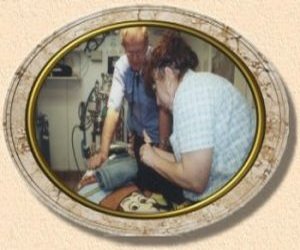The tranquilization is always an option for the animal owner and the final decision is made, by the owner, whether to use it or not. But Dr. De Grasse strongly recommends tranquilization under the following conditions:
It must be noted that all situations are considered on an individual basis and discussed, at length, with the veterinarian, Dr. De Grasse and the animal's owner present. The above mentioned list is not complete and additional circumstances can always occur.
The benefits of tranquilization allows very precise chiropractic work to be performed, provides a period of rest for the animal to allow the chiropractic adjustment to "set" and allows the animal's owner to learn specific traction techniques, when indicated. Dr. De Grasse also believes that the tranquilization can also allow the "stressed" animal to get into a "deep" sleep that perhaps was unavailable before due to trauma or pain. Tranquilization is also a valuable tool when the exotic animal is not accustomed to human touch.
Care of the Animal After Tranquilization
The tranquilizing medications used in Dr. De Grasse's practice makes the animal act like a "drunken sailor". Caution should be taken that the animal does not slip or fall on any slick surface such as tile or wooden floors. The animal cannot be trusted to stay on the couch or bed and should not be left unattended as a fall or slip unto the floor is likely. The tranquilizer dulls the animal's senses of the environment and fine control of the muscles may be altered. The gait will be staggered (drunken), unbalanced and uncoordinated. This phenomenon may last up to 24-30 hours after administration of the medication. This effect is expected for this duration of time and is not from an overdose of medication.
Dr. De Grasse prefers that all animals be kept away from the tranquilized animal and that children be closely monitored or removed from the animal's presence. The tranquilized animal's behavior may be altered and should not be trusted around small children. Every 3 or 4 hours the animal should gently be repositioned side to side if the animal has not done so himself. And the animal must be kept in a controlled environment where the temperature is stable. The animal's ability to regulate his body temperature may be compromised temporarily.
Sedation
Sedation is when the animal is under a full anesthetic for a short period of time. Dr. De Grasse usually completes her chiropractic work within 10-20 minutes while utilizing a full anesthetic. The animal must not have eaten or drank for at least 6-8 hours prior to the administration of the anesthetic and the element of anesthetic risk is higher than when using tranquilization. The same medications are used as if the animal were to undergo a surgical procedure. All possible precautions are taken and this recommendation is not given lightly.
It must be noted that because of the ability to utilize a full anesthetic, Dr. De Grasse has been able to return over 630 paralyzed animals to mobility. It is with the paralyzed animal that a deep chiropractic adjustment must be administered, within a very timely manner, to prevent the spinal cord or spinal nerves from dying. It is also with the paralyzed animal that significant amounts of pain and specific postures due to extreme pain are observed. The relaxation of the animal and the ability of the chiropractic adjustment to be very specific are critical to restoring normal blood and nerve flow to the spinal nerves and cord.
Please note: Dr. De Grasse's chiropractic work while the animal is under a general anesthetic is considered controversial by some veterinarians but every owner of a paralyzed animal that is now walking - has a different opinion!
Conditions that may require sedation:
paralysis (partial or complete)
extreme pain or fear
correction of a mega-esophagus
extreme trauma
head dislocation
correction of hip dysplasia (some conditions)
sprung pelvis
exotic work (some conditions or species)
critical upper cervical (neck) work
